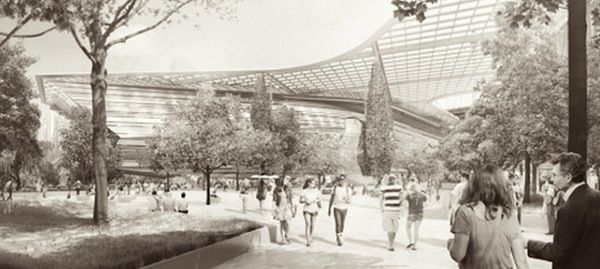When looking for an architect to design the academic building for the Cornell NYC Tech campus on New York City’s Roosevelt Island, it was a progressive, form-follows-function approach that drew Cornell University to Thom Mayne and his firm, Morphosis Architects.
Daniel Huttenlocher, future dean of Cornell NYC Tech, told the New York Times that he was “heartened by an architect who doesn’t want to get too caught up in the form too early in the process.”
Mayne is fully aware that the building must respond to a unique island site and ambitious environmental goals. “The architecture is absolutely determined by the program” he says. “It is about the intersection of the urban, academic and environmental program requirements,” such as the shape of the “lilly pad of photovoltaics.”
Mayne’s phase-one academic building will set the tone for the rest of the Cornell campus, and has attracted attention with its promise of being the largest net-zero energy building in the eastern U.S. Skidmore Owings & Merill (SOM), master planners on the project, prioritized the energy standards, declaring that “the need to produce, and conserve, energy will affect every aspect of the design, with strictly formal considerations giving way to a ‘new aesthetic’ of sustainability.”
The architecture must also take the tech campus’ academic program into account. In an October interview with Next American City, Colin Koop of SOM emphasized that permeability and interconnected public space was critical for idea sharing and interaction — and avoiding a “security badge campus.” Mayne agrees, explaining that for Cornell NYC Tech, “it is important to create a social environment that will maximize creative capital.” He adds that he is seeing a shift in campus architecture towards academic buildings that aren’t merely architectural icons, but “connect to a social environment.”
Morphosis’ flexible and iterative design process allows the building to respond to challenging program requirements and environmental standards, and means that the building is continually evolving. While the architects focus in on the “intersection of art and function,” Mayne points to the public’s preoccupation with the design: “People have been very concerned about the images of the building,” he says, but “they need to realize that the released renderings were pre-schematic. In fact, we are still working.”
The first design drafts, he says, will be released in about a month.
Mayne says he sees projects only increasing in scale and complexity in the 21st century, necessitating what he describes as a more “strategic and tactical design approach.” He downplays the role of aesthetics, instead suggesting a “more interpretive and qualitative” approach that acknowledges factors beyond than the physical components of the urban fabric. Mayne is interested in a new paradigm that combines architecture and planning in a hybrid space — something that has been a mantra at his firm for decades, and is explored in his newly released book, Combinatory Urbanism: The Complex Behavior of Collective Form.
“I see architecture’s role in planning becoming much bigger,” Mayne says.
















